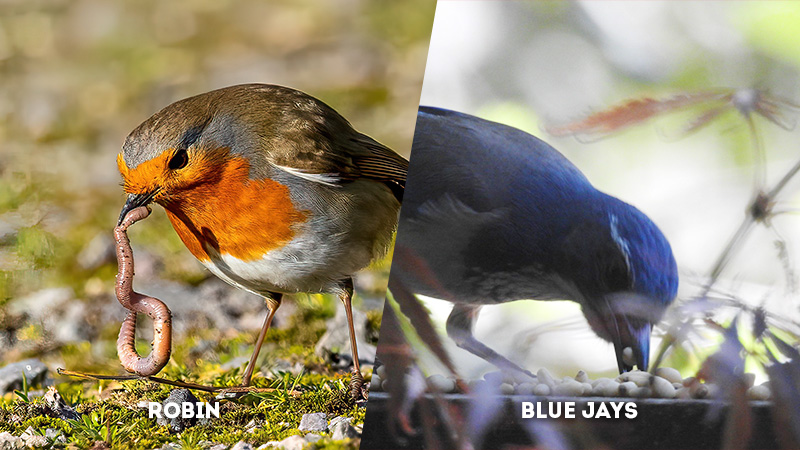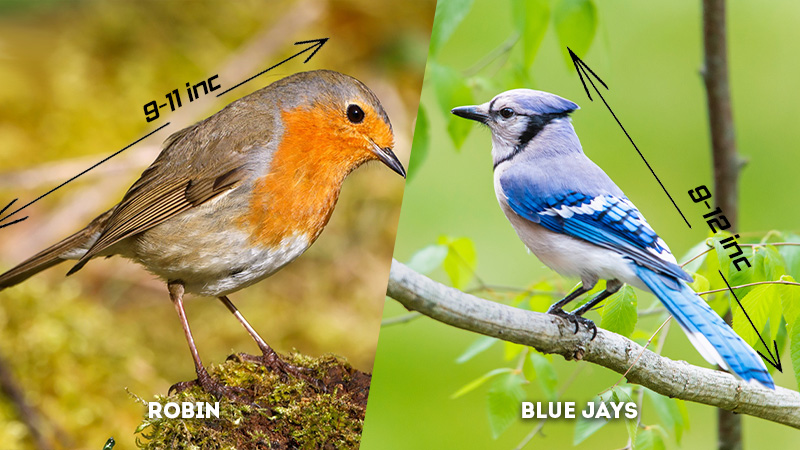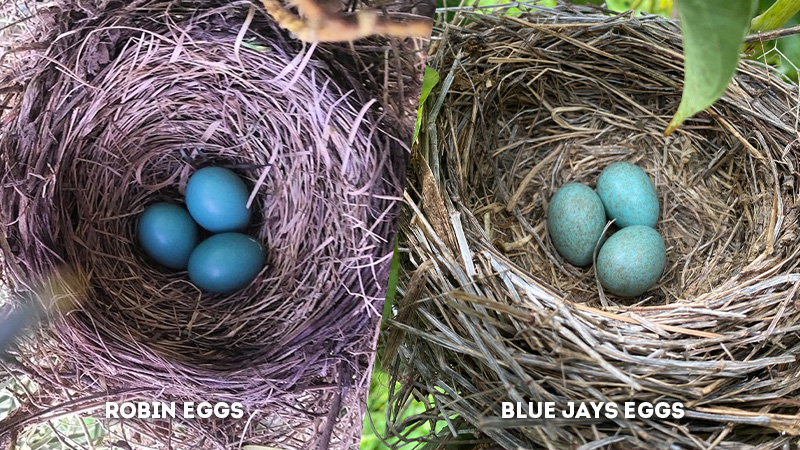Robins and blue jays, two distinct bird species, captivate with their vibrant behaviors and characteristics. These avian counterparts embody diverse traits, from melodious calls to exceptional mimicry, each shaped by evolutionary adaptations.
Exploring the contrasts between robins and blue jays sheds light on their responses to environmental challenges and the strategies they employ for survival.
This exploration unveils the intricate interplay of factors that define their roles within ecosystems and our appreciation for the marvels of nature’s diversity.

Key Differences Between Robin and Blue Jay
Robin and Blue Jay are two different species of birds, and they have distinct characteristics and behaviors. Here’s a comparison between the two:
Call Characteristics
- Robin: Robins are known for their melodious and unique song that often marks the beginning of spring mornings. Their song is a series of melodious phrases that can vary between individuals and regions. It’s often a sweet, clear, and repetitive tune that is both recognizable and soothing.
- Blue Jay: In contrast, Blue Jays possess a remarkable mimicry ability. They can imitate a wide range of sounds, including other bird calls and even certain animal noises.
This mimicry serves various purposes, from deceiving other birds to defending their territory. Blue Jays’ calls are diverse, from harsh squawks to melodious notes, showcasing their flexibility in vocalizations.
Coloration
- Robin: Robins exhibit a color palette dominated by reddish-brown tones on their breast, with a grey back and a white belly. This coloration provides them with a degree of camouflage in natural environments like forests and gardens.
- Blue Jay: Blue Jays are renowned for their striking and vibrant appearance. Their plumage consists of brilliant blue feathers on their wings, tail, and head, contrasting with bold black and white markings.
In some cases, they also feature hints of red in their plumage. This coloration makes them stand out prominently in various habitats.
Learning Abilities
- Robin: While Robins are not known for their advanced learning capabilities, they do exhibit a level of intelligence suited to their ecological needs.
They can learn to identify suitable foraging areas and locate food sources, but their learning is generally more focused on survival skills rather than complex tasks. - Blue Jay: Blue Jays, on the other hand, possess impressive cognitive abilities. They are quick learners and can adapt to new situations with ease.
Their capacity to mimic various sounds, including human-made noises, showcases their intelligence and versatility in learning.
Distinctive Markings
- Robin: The distinctive markings of Robins are characterized by their reddish breast, dark grey back, and white belly.
This combination of colors provides effective camouflage in their natural habitat, allowing them to blend into their surroundings and avoid potential predators. - Blue Jay: Blue Jays’ distinctive markings include their brilliant blue feathers, bold black markings, and accents of white.
The vibrant blue coloration and the stark contrast of black and white serve as both an attractive feature and a way to establish their identity within their territory.
Mimicry
- Robin: Robins are not particularly known for mimicry. Their focus is more on their melodious and unique song that serves to establish territory and attract mates.
While they might incorporate various elements into their songs, it’s not as sophisticated as the mimicry displayed by Blue Jays. - Blue Jay: The Blue Jay’s mimicry ability is a standout characteristic. They can imitate the calls of other birds, animals, and even mechanical sounds.
This mimicry helps them confuse predators, protect their territory, and potentially deceive other birds, showcasing their adaptability and intelligence.
Feeding Habits
- Robin: Robins are primarily insectivorous birds. They forage on the ground, hopping and walking, to search for insects, earthworms, and other invertebrates.
Their diet might also include berries and fruits, especially during the winter months when insects are less abundant. - Blue Jay: Blue Jays are known for their omnivorous diet. They have a varied palate that includes insects, fruits, nuts, seeds, and even small vertebrates.
Their adaptability in finding and consuming different types of food contributes to their survival in a range of environments.
Nesting Preferences
- Robin: Robins prefer to build their nests in shrubs, trees, and other elevated locations. Their cup-shaped nests are usually situated in concealed spots, providing protection for their eggs and nestlings against predators.
- Blue Jay: Blue Jays also nest in trees, utilizing well-concealed locations to safeguard their nests. Their nests are often constructed at higher elevations, and they might reuse old nests or build new ones depending on the circumstances.
Nesting Material
- Robin: Robins construct their nests using a combination of materials, including grass, twigs, and mud. This mixture creates a sturdy and protective nest structure for their eggs and hatchlings.
- Blue Jay: Blue Jays exhibit a similar nesting material approach, utilizing twigs, feathers, and mud in their nest-building process. These materials help create a robust and insulated nesting environment for their young.
Territorial Behavior
- Robin: Robins are known for their territorial behavior, especially during the breeding season. They vigorously defend their nesting territories, often engaging in territorial disputes with other robins or potential competitors.
- Blue Jay: Blue Jays are also territorial birds, although their territoriality might extend to a broader area. They can be aggressive when it comes to protecting their resources, including food sources and nesting sites.
Migration Patterns
- Robin: Many robins are migratory birds, often making seasonal journeys between breeding and wintering grounds. In some regions, robins might remain year-round, especially if they have access to suitable food sources during colder months.
- Blue Jay: Blue Jays’ migration patterns are more complex and can vary geographically. While some Blue Jays are migratory, others might remain in their habitats throughout the year. Their migration depends on factors such as food availability and climate.
Behavior in Winter
- Robin: Robins exhibit varying behavior in winter, with some populations being migratory and others remaining in non-migratory regions.
Those that remain might rely on their ability to find food sources such as berries and fruits, adapting their foraging habits to the availability of resources. - Blue Jay: Blue Jays are active throughout the winter months. They are known to store food during the fall, burying nuts and seeds for later consumption. This behavior demonstrates their ability to plan for the future and endure harsh conditions.
Social Behavior
- Robin: Robins tend to be more solitary in nature. While they might form loose flocks during migration, they generally prefer individual foraging and territorial behavior during the breeding season.
- Blue Jay: Blue Jays exhibit a higher degree of social behavior. They often form family groups and can be seen foraging, traveling, and even nesting together. This social structure can help with predator detection and resource sharing.
Song Complexity
- Robin: Robins are known for their melodious and repetitive song, which they use to establish territory and attract mates. Their song consists of clear, flute-like notes that vary regionally but generally have a consistent structure.
- Blue Jay: Blue Jays are capable of producing a wide range of calls, each with its own purpose. Their calls can be harsh squawks or melodious notes, and they are also skilled at mimicking other birds and animals. This versatility showcases their complexity in vocalizations.
Eating Preferences

- Robin: Robins primarily feed on insects, worms, and other invertebrates, especially during the breeding season. However, they might switch to a diet of berries and fruits, such as holly and juniper, when insects are less abundant in colder months.
- Blue Jay: Blue Jays have a diverse diet, including insects, fruits, nuts, seeds, and even small vertebrates. This omnivorous behavior allows them to exploit various food sources in their habitat.
Size

- Robin: Robins are relatively smaller in size compared to Blue Jays. They have a compact body structure with an average length of around 9-11 inches (23-28 cm) and a wingspan of approximately 12-16 inches (30-41 cm).
- Blue Jay: Blue Jays are larger birds, characterized by their robust build and long tail. They measure around 9-12 inches (30 cm) in length with a wingspan of 13-17 inches (33-43 cm). Their size and powerful flight contribute to their survival strategies.
Range
- Robin: Robins have a widespread distribution, inhabiting a variety of habitats across North America, Europe, and Asia.
Their adaptable nature enables them to live in diverse environments, from woodlands and gardens to urban areas. Robins’ ranges vary according to their subspecies and migratory behavior. - Blue Jay: Blue Jays, while also adaptable, are primarily found in North America. They inhabit forests, woodlands, parks, and urban areas, often preferring areas with trees for nesting and cover.
Their range extends from Canada through the United States, exhibiting a more localized distribution compared to the robin.
Nesting Season
- Robin: Robins typically have a nesting season that spans from spring to early summer. This timing aligns with the availability of insects, which form a significant portion of their diet. They build their nests in preparation for raising their young during the warmer months.
- Blue Jay: Blue Jays have a nesting season that generally starts in the spring and extends into mid-summer. Their nesting schedule accommodates the diverse diet they consume, including insects, fruits, and nuts.
Egg Color

- Robin: Robins’ eggs are light blue in color and often adorned with brown speckles. This coloring provides camouflage within the nest and surroundings, helping protect the eggs from potential predators.
- Blue Jay: Blue Jays’ eggs are also light blue, resembling the color of the sky. The eggs might have brown speckles, but the main coloration serves as a subtle form of camouflage against potential threats.
Parental Care
- Robin: Robins are diligent parents. Both the male and female participate in building the nest, incubating the eggs, and feeding the chicks. They work together to provide for their young, ensuring their survival and growth.
- Blue Jay: Blue Jays also exhibit cooperative parental care. Both parents contribute to nest-building, incubation, and feeding the nestlings.
Their social behavior extends to parenting, with family groups working together to raise their offspring.
Mobility
- Robin: Robins display mobility primarily on the ground. Their hopping and walking movements are suited to foraging for insects and worms in leaf litter and on lawns. Their wings are more commonly used for flight rather than extensive movement on the ground.
- Blue Jay: Blue Jays are more mobile in the air, relying heavily on their powerful flight capabilities to move between trees and foraging sites. Their agility in the air aids in both foraging and avoiding potential threats.
Intelligence
- Robin: Robins display moderate cognitive abilities that aid them in tasks like foraging and finding suitable nesting sites.
They have a good understanding of their environment and are able to adapt their behavior based on seasonal changes and resource availability. - Blue Jay: Blue Jays are recognized for their high intelligence. They exhibit problem-solving skills, memory retention, and the ability to learn quickly. Their intelligence is evident in their mimicry of other animals’ calls and their knack for hiding and retrieving food caches.
Predator Imitation
- Robin: Robins do not frequently engage in predator imitation. They primarily rely on their melodious song and alert calls to communicate with other robins and establish their territory.
- Blue Jay: Blue Jays are known for their remarkable ability to imitate predator calls, particularly mimicking the calls of hawks.
This skill serves as a defense mechanism, scaring off other birds and potential predators, and highlighting their adaptability in utilizing various strategies for protection.
Winter Adaptations
- Robin: Robins’ winter adaptations vary depending on their location and food availability. Some populations might migrate to warmer regions, while others remain in their non-migratory habitats and rely on berries and fruits for sustenance during the colder months.
- Blue Jay: Blue Jays exhibit robust winter adaptations. They store food during the fall by burying nuts and seeds, creating a hidden food supply that they can access when other food sources are scarce. This caching behavior showcases their foresight and planning for harsher conditions.
Urban Adaptability
- Robin: Robins are relatively adaptable to urban environments, often found in gardens, parks, and suburban areas. They utilize these settings for foraging and nesting, demonstrating their flexibility in coexisting with human-altered landscapes.
- Blue Jay: Blue Jays are known to adapt well to urban settings too. Their omnivorous diet and versatile foraging habits enable them to take advantage of food sources provided by human activities, such as bird feeders and discarded food.
Egg Clutch Size
- Robin: Robins typically lay clutches of 3-5 eggs. This moderate clutch size allows the parents to efficiently incubate the eggs and care for the nestlings, ensuring a balanced allocation of resources.
- Blue Jay: Blue Jays tend to lay larger clutches, usually containing 3-7 eggs. Their larger clutch size might be attributed to their cooperative parenting behavior, where both parents participate in rearing the offspring, increasing the chances of survival for a larger brood.
Lifespan
- Robin: Robins have a relatively short lifespan, with most individuals living a few years in the wild. Their lives are marked by challenges such as predation, environmental hazards, and competition for resources.
- Blue Jay: Blue Jays have a longer lifespan compared to robins. They can live up to 7 years in the wild, benefiting from their intelligence, adaptability, and ability to store food for sustenance during harsh conditions.
Robin Vs Blue Jay: Comparison Table
| Feature | Robin | Blue Jay |
|---|---|---|
| Call Characteristics | Melodious and unique song | Mimics various calls, including other birds |
| Coloration | Reddish-brown breast, grey back, white belly | Blue, white, black, red (varies by individual) |
| Learning Abilities | Moderate learning capabilities | Highly intelligent, capable of learning quickly |
| Distinctive Markings | Dark grey, black, brown with a reddish breast | Bright blue plumage with black and white |
| Mimicry | Limited mimicry skills | Exceptional mimicry of other animals’ calls |
| Feeding Habits | Forages on ground for insects and worms | Consumes a wide range of foods, including nuts |
| Nesting Preferences | Builds cup-shaped nests in shrubs and trees | Nests in trees, well-concealed locations |
| Nesting Material | Uses grass, twigs, and mud for nests | Creates nests with twigs, feathers, and mud |
| Territorial Behavior | Defends nesting territory vigorously | Can be territorial and aggressive |
| Migration Patterns | Often migrates to warmer regions | May migrate in some regions |
| Behavior in Winter | May stay in non-migratory regions | Stays active and may store food for winter |
| Social Behavior | Generally more solitary | Can be social and live in family groups |
| Song Complexity | Melodious but not as varied as some species | Varied calls, including harsh and melodious |
| Eating Preferences | Primarily insectivorous | Omnivorous diet, including seeds and insects |
| Size | Smaller in size compared to Blue Jays | Larger in size compared to Robins |
| Range | Found in various habitats worldwide | Predominantly North America |
| Nesting Season | Spring and early summer | Spring to mid-summer |
| Egg Color | Light blue with speckles | Light blue with brown speckles |
| Parental Care | Both parents participate in feeding chicks | Both parents participate in rearing offspring |
| Mobility | Hops and walks on the ground | Agile in flight and perching |
| Intelligence | Moderate cognitive abilities | Highly intelligent, can solve complex tasks |
| Predator Imitation | Rarely imitates predators’ calls | Mimics hawk calls to scare off other birds |
| Winter Adaptations | Fluffs up feathers for insulation | Stores and hides food for winter |
| Urban Adaptability | Tolerates urban environments | Can adapt to urban settings as well |
| Egg Clutch Size | Usually 3-5 eggs per clutch | Usually 3-7 eggs per clutch |
| Lifespan | Average lifespan of a few years | Can live up to 7 years in the wild |
Frequently Asked Questions
While both robins and bluejays can be found in overlapping geographical regions, their specific habitats within these regions often differ. Robins are more widespread and adaptable, inhabiting various environments including woodlands, gardens, and urban areas. Blue jays are primarily found in North America, preferring forested areas, parks, and suburban landscapes.
Both robins and blue jays use body language and postures to communicate with each other. For instance, displaying raised crests or fluffing up feathers can signal excitement or aggression. Additionally, they might use visual cues during courtship or territorial disputes to convey their intentions to other members of their species.
Yes, both robins and blue jays have natural predators. For robins, predators include cats, snakes, raccoons, and larger birds such as hawks and owls. Blue jays are also susceptible to predation by raptors, snakes, and mammals like squirrels and foxes. Their predator imitation calls can serve as a defensive strategy to deter potential threats.
Robins play a role in controlling insect populations, which can have cascading effects on plant health. Their feeding habits help regulate insect pests, benefiting both plants and other animals in their habitats. Blue jays contribute to seed dispersal by caching and forgetting about stored nuts and seeds, which can lead to the growth of new plants and trees in various locations.
Yes, both robins and blue jays have cultural significance in different contexts. Robins are often associated with the arrival of spring and renewal due to their distinctive song coinciding with the changing seasons. In some Native American traditions, blue jays are seen as symbols of curiosity, communication, and adaptability. However, they can also be associated with mischievous or opportunistic behavior due to their adaptability to various environments and their fondness for stealing eggs from other birds’ nests.
To Recap
The distinct attributes of robins and blue jays paint a vivid portrait of nature’s ingenuity.
From the melodic songs of robins heralding spring’s arrival to the mimicry skills of blue jays that baffle predators, these species exemplify the multifaceted strategies that have evolved to ensure their existence.
Through differences in behavior, adaptability, and survival mechanisms, robins and blue jays offer a glimpse into the remarkable tapestry of life’s diversity.
Their stories inspire us to further explore the intricacies of the natural world and foster a deeper connection with the avian wonders that grace our surroundings.